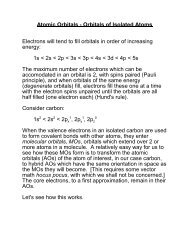Chapter 7 Electron Configurations and the Properties of Atoms 7.1 ...
Chapter 7 Electron Configurations and the Properties of Atoms 7.1 ...
Chapter 7 Electron Configurations and the Properties of Atoms 7.1 ...
You also want an ePaper? Increase the reach of your titles
YUMPU automatically turns print PDFs into web optimized ePapers that Google loves.
<strong>Chapter</strong> 7 <strong>Electron</strong>ic <strong>Configurations</strong> <strong>and</strong> <strong>the</strong> <strong>Properties</strong> <strong>of</strong> <strong>Atoms</strong><br />
example, arsenic, As, is a p-block element. To “count up” to As, you begin with <strong>the</strong> first-row<br />
elements, H <strong>and</strong> He, each <strong>of</strong> which represents an electron in <strong>the</strong> 1s orbital (1s 2 ). Next, Li <strong>and</strong> Be<br />
represent 2s 2 <strong>and</strong> B through Ne represent 2p 6 . Similarly, Na <strong>and</strong> Mg represent 3s 2 <strong>and</strong> Al through Ar<br />
represent 3p 6 . In <strong>the</strong> fourth row <strong>of</strong> <strong>the</strong> periodic table, K <strong>and</strong> Ca represent 4s 2 , Sc through Zn represent<br />
3d 10 , <strong>and</strong> Ga through As represent three electrons in <strong>the</strong> 4p orbital, 4p 3 . The electron configuration <strong>of</strong><br />
arsenic is<br />
As: 1s 2 2s 2 2p 6 3s 2 3p 6 4s 2 3d 10 4p 3 [Ar]4s 2 3d 10 4p 3<br />
7.4 <strong>Properties</strong> <strong>of</strong> <strong>Atoms</strong><br />
Section Outline<br />
7.4a Trends in Orbital Energies<br />
7.4b Atomic Size<br />
7.4c Ionization Energy<br />
7.4d <strong>Electron</strong> Affinity<br />
Section Summary Assignment<br />
<strong>Electron</strong> configurations play a large role in determining <strong>the</strong> properties <strong>of</strong> atoms. Some <strong>of</strong> <strong>the</strong> key<br />
factors that influence atomic properties include <strong>the</strong> size <strong>of</strong> <strong>the</strong> largest occupied orbitals, <strong>the</strong> energy <strong>of</strong><br />
<strong>the</strong> highest-energy orbitals, <strong>the</strong> number <strong>of</strong> orbital vacancies, <strong>and</strong> <strong>the</strong> number <strong>of</strong> electrons in <strong>the</strong><br />
highest-energy orbitals. Most atomic properties can be related to <strong>the</strong> degree <strong>of</strong> attraction between <strong>the</strong><br />
outermost electrons to <strong>the</strong> nucleus, <strong>and</strong> <strong>the</strong> number <strong>of</strong> electrons in <strong>the</strong> outermost electron shell, <strong>the</strong><br />
number <strong>of</strong> valence electrons.<br />
Opening Exploration 7.4 Orbital Energies <strong>and</strong> Atomic <strong>Properties</strong><br />
7.4a Trends in Orbital Energies<br />
As shown in <strong>the</strong> previous section, <strong>the</strong> organization <strong>of</strong> <strong>the</strong> periodic table is closely related to electron<br />
configurations. The energy <strong>of</strong> atomic orbitals is also related to <strong>the</strong> structure <strong>of</strong> <strong>the</strong> periodic table.<br />
As you move down within a group, <strong>the</strong> energy <strong>of</strong> highest-energy occupied orbitals increases.<br />
Likewise, <strong>the</strong> elements have greater numbers <strong>of</strong> electrons, <strong>and</strong> <strong>the</strong>y occupy orbitals with higher n. As<br />
<strong>the</strong> value <strong>of</strong> n increases from element to element, <strong>the</strong> orbitals are larger, <strong>the</strong> electrons in <strong>the</strong>se orbitals<br />
- 14 -
















